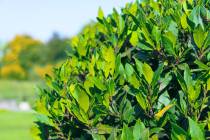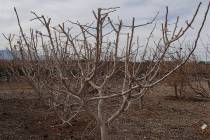Vacuum zucchini to rid plant of squash bugs
Saturday I will present a demonstration on summer pruning fruit trees at the University of Nevada Cooperative Extension Master Gardener Orchard in North Las Vegas. Summer pruning is used to help keep standard-sized fruit trees dwarfed by robbing them of their excessive spring growth. Most summer pruning can be done with your hands .
The class will start promptly at 9 a.m. and last about one hour. No registration or fees are required. Call the master gardener help line at 257-5555 for directions to the orchard.
Gilcrease Orchard will have its 2011 opening Saturday from 7 a.m. to noon. It is only about 1½ miles to the west of the UNCE orchard so you can visit both when coming to the north part of the valley. It will have carrots, beets, arugula, Swiss chard, green onions and snap peas. Across the street to the northwest from Gilcrease are Sharon's famous eggs at The Farm .
If you missed getting the fruit trees that I recommend for our valley, then you will have another chance. My recommended fruit tree varieties are being brought in by Plant World Nursery on Charleston Boulevard around the first week of May. I will be at the nursery May 8 at about 11 a.m. to help with your selections and give advice on planting, fertilizing and pest control.
You can obtain a list of my recommended fruit trees for our area by visiting http://xtremehorticulture.blogsport.com.
Now is a great time to prune your palms if they had winter damage. They are pushing new growth, so any pruning will be replaced with new growth during the next month. If the palm frond has substantial browning from cold damage, remove the frond as close to the trunk as possible. While you are at it, on some palms you may see the flower stems emerging; you can eliminate the fruit if it has been a problem in the past.
Q: Every year my zucchini plants are infested with gray-colored beetles that destroy my zucchini. How do I get rid of the beetles?
A: They are most likely squash bugs. You can plant late, in June, after their infestation time has passed or you can hand pick them as you see them. You must do this as they appear soon after planting and get rid of them as soon as you see them. Do this for about three weeks and the numbers will be greatly reduced.
Or you can vacuum them with a hand-held vacuum cleaner, vacuuming the undersides of the leaves. You can use pesticides suitable for squash bugs but be sure to spray the undersides of the leaves. Do not spray plants when in bloom. Spray very early in the morning or at sunset when bees are not active.
Q: Our house plants seem to breed a small black gnat. We use potting soil with our African violets and herbs. Is there anything we can do? It has been suggested that we use a soapy water spray?
A: The gnat larvae feed on organic matter in the soil and frequently on the roots of plants as well. There is an organic spray that can be used for fungus gnats that contains a bacterium called Bt. There are different strains of Bt so the one you use to control wormy tomatoes, corn earworm or grape leaf skeletonizer won't work on fungus gnats. The strain has to be israelensis, sometimes designated as H-14 or strain AM 65-52.
One product that contains this form of Bt is manufactured by Valent Biosciences and is called Knock-Out. It is available online from Gardens Alive. It is a liquid and applied to the soil. I have not seen it available in town. Follow the label directions.
Curiously enough, research indicates that Bounce fabric softener dryer sheets repels some fungus gnats.
Q: We have a blood orange tree in the backyard facing west. We only had fruits the first year, which was seven years ago. Since then we have had no fruit or flowers. The tree is growing well. Every year we have new branches and lots of new leaves. Our Mexican lime tree has only a few limes a year even though we have a lot of flowers. We used avocado and citrus fertilizer but have had no luck.
A: Both blood orange and lime are tender here compared to lemon, grapefruit and mandarin orange. I am wondering if you are losing some potential fruit from some late spring freezing weather. If that is the case, you would see the trees as healthy and bushy but without fruit.
I think you may have to give your lime some protection from late spring freezes by throwing a covering over the tree, especially if nighttime temperatures drop to below freezing . Flowers will not survive any temperatures below 32 F. This year, for instance, we lost many of our early peach fruit and quite a few apricot fruits due to late freezes. Some years we lose pluots and plums depending on when the freezes occur and how low the temperatures get.
The worst case is to have low temperatures in a windy spot. The closer to a hot west or south wall and protection from wind the better your tender citrus will perform.
Q: These pictures are of our bottle brush plants. We live in Summerlin and got snow and frost this winter. Can you tell from these pictures if they are savable or gone?
A: It is hard to say from the picture because you can have freezing damage to the leaves where they look dead and still have the stems alive. This will cause the leaves to brown and possibly drop but the plant will still be alive. You can do some checking for life by bending the stems in different places. Plants that are alive will usually remain pliable.
Wait for some growth to occur this spring before removing the plants or making any cuts. Make your cuts when and where you see new, strong growth.
Fertilize with compost or any landscape fertilizer formulated for trees and shrubs. Add some iron chelate that has the acronym EDDHA in the ingredients. Add fertilizer and iron now .
Q: The compost from my compost pile had lots of juicy worms when I put the soil into large containers for my tomatoes and smaller pots where I grow herbs. Should I put something into the containers as food for the worms?
A: As long as there is organic matter present in the soil the worms will be fine. Twice a year or when you transplant into the containers, add compost for the plants and the worms or decomposing vegetable kitchen scraps and cover these scraps with wood mulch to help the decay process.
Bob Morris is an associate professor with the University of Nevada Cooperative Extension. Direct gardening questions to the master gardener hot line at 257-5555 or contact Morris by email at morrisr@unce.unr.edu.























